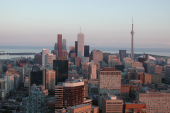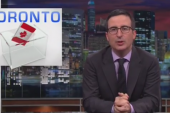
All images courtesy of Justin Robertson
I recently flicked through the 282-page Monocle Quality of Life Survey 2012 , an annual summer read that puts a microscope on city design, concepts and ideas from around the world. What the publication did was tap into their whopping collection of 29 correspondents from around the globe who set about the task of finding out: what makes a city livable?
It provoked thought on cities, like the recent population boom in Texas, it compared the price of a travel ticket through Europe, how Zimbabwe is hungry for change and high density housing in Auckland. The Monocle also created lists: the best sport cities, 50 things you need for a better quality of life, how a popular TV series can boost a city’s image and five cities you’ll hear more from. Toronto, for what it’s worth, did not make their top 25 most livable city list; something that Vancouver and Montreal achieved. They also didn’t make the best sport cities list, or the five loveable cities list. Toronto though, did get a plug for the Tower Renewal project, an initiative heavily supported by former mayor David Miller and founded by Graeme Stewart, but as far as transit and connectivity and willingness to be dynamic, what the quality of living survey showed – or rather, exposed – was how much Toronto seemed to be lagging behind other city hubs.
So is Toronto really dawdling behind other world cities or is the Monocle’s latest survey just another list we don’t care about anyway? As with any survey, there will always be debate about which cities deserve to be included, but are some more noteworthy than others and which livable city surveys should we pay more attention to? It seems like there is one released every six months, each with their own insistent criteria.
The most recent was The 2012 Economist Intelligence Unit’s bi-annual (they also have an annual livability index) livability index. They ranked Toronto eighth based on population, density, air quality, connectivity and green space. Another notable annual digest is Mercer’s Quality of Living Survey which compares 221 cities based on an enormous 39 criteria. The catch? Every city is compared to New York (who is given a score of 100) and are rated on: safety, education, hygiene, health care, culture, environment, stability and public transit — just to name a few. In 2011, Toronto ranked 15th and, 16th the previous year.
***
Livable city surveys, though, are just a guide. They don’t urge changes; they simply document what already exists. And with a high rank comes smugness — It’s a knee-jerk reaction. There’s a sense of personal satisfaction to know that you made the right choice settling in one of the top ten livable cities; you also, too, become the envy of every foreigner. People want to come to your city and when you head overseas and say “I live in Toronto”, you’ll get the reply “Oh, I’ve always wanted to travel there.” Then, locally there’s also bragging rights to consider. When Vancouver edges out Toronto in world city rankings, Hogtown is the first to know about it. And vice versa.
So with that, should we completely ignore livable city surveys? Well, no. They are worth paying attention to.
Here’s why.
The cities that made Monocle’s top 25 list — the top three being Zurich, Copenhagen and Helsinki — seemed like worthy contenders. For, it’s these same city hubs that have built rail networks from their sprawling Universities right to the doorstep of their downtown core and developed livable neighbourhoods with a raft of diverse businesses in between. Some of these hubs have cut the cost of a public transit ticket to get more bums on seats. In Vienna, for example, $1.20 gets you a day pass; $50 for the month. That’s at least half of what we pay here in Toronto. These surveys, as frequent as they churn out, do provoke continuing discussion on what makes a city deemed “livable” and what is it about other cities that you should be thinking about in your own city.
I’ve been a commuter in Toronto for the past eight years. I don’t own a car, but can appreciate the connectivity of some countries who have built a first-class rail network either from downtown to the airport (Toronto is on track for the Air Rail Link due for completion in 2015, but that has no local stops) or simply connecting people to the city from hard to reach places. My three-hour daily commute to Humber North for two years wore thin very quickly. No matter what bus route or train line I took, it always felt like a marathon effort, as if I were crossing country borders. Buses fought congestion; trains encountered delays. Other cities have seamless urban transit plans that allow people to cycle to a University that doesn’t take 15 hours out of your week. In Copenhagen, 50 per cent commute by bike, to work and school. In Toronto, out of 2.4 million commuters, a 2006 Statistics Canada study showed 71.1 per cent used a car to get to work, 22.2 used public transit, 4.8 per cent walked and one per cent biked. We’ve become an automobile society.
***
The Monocle survey pointed out some cities are more willing, enterprising and prepared to change their existing infrastructure for peerless connectivity. In Zurich, a new tramline now connects a newly-built industrial neighbourhood with the city hub, running every five minutes at a punctuality rate of 96 per cent. Helsinki’s green space occupies one-third of the city and they’re transforming former sea-side harbours into residential areas as well as installing a new metro line that will reach the western parts of the city and transport more than 100,000 passengers daily. The Danes excel in transport infrastructure and things like bike super highways. They’ve now developed a private airline route (to the tune of 27-million) to attract new airline routes to the city. Jealous yet?
We too could have these things, but Toronto’s aversion to take risks has mired it in mediocrity. Take the Gardiner Expressway, for example. Under Mayor Miller’s reign, plans to beautify the highway were ignored or considered too costly. Among the ideas: a glass tube (a curved glass cover the reduce noise); greenery (plans to add a garden roof with trees, bike paths similar to New York’s High Line); a cable bridge (more traffic lanes and a covered bike path); and underground (re-route the highway underground, the same way Boston did, but estimates were around $2-billion). Even the Waterfront revitalization seemed like a waste with its flashy new docks and parks. Not because it didn’t fit with the city, but right next to it sits slabs of concrete from the Gardiner, congestion and cars and, cranes and condo developments. We have a great big lake that no-one can see or appreciate because the view obscured. When I think of a waterfront well done, Chicago comes to mind with an even mix of low-rise and high-rise buildings and a bustling Chicago river and waterfront scene full of businesses, bars and places you can hire bikes — and visible to other parts of the city.
The intensification of Toronto’s downtown core has also made it ironically impossible to increase transit possibilities. It seems like it would be much easier to build a rail network, from scratch, to a new growth region of the city rather than figure out ways to re-develop existing infrastructure — but there’s no space, and there lies Toronto’s challenge. Growth, too, depends on government funding when you have a publicly-owned and operated transit system. Perhaps privitization is the way forward, like other cities have opted for, but that too has it’s flaws with little to no accountability when infrastructure goes pear-shaped. An emerging trend in city planning shows there is merit to having a long-term urban planner to focus on development and vision. In places like Copenhagen, New York and Melbourne, forward-thinking planners have resuscitated life back into congestion-heavy and abandoned parts of the city. It doesn’t bode well for Toronto to know that they still have not hired a full time city planner since the previous chief planner, Gary Wright, retired in March this year. No planner, no vision.
Probably the coolest item in the Monocle survey, was a look at Japan’s vending machine culture. While Toronto recently decided “no” on food trucks, mainly because restaurateurs fear the competition and also space for more permits has raised eyebrows (its been referred back to City of Toronto’s executive committee for further investigation), Japan’s kitschy vending machine love affair is a great example of what can work if you invest wholeheartedly. The Tokyo vending machine industry raked in $65 million dollars last year, with more than five million of them on street corners, inside subway platforms, selling iced drinks, hot teas and coffee, soups, ice-cream, hot meals, socks and razors. If street vendors and food trucks can’t get a permanent foot in the door, what not try vending machines?
And recently city councillors voted “no” — overwhelmingly — 43-1 against TTC Chair Karen Stintz’s OneCity plan for what they called a rather costly project and a logistical nightmare.
In the meantime, other cities are forging ahead with clear visions, creating better architectural designs and longer opening bar hours leading to a better quality life. Toronto is accustomed to deciding “no” when it comes things like injecting new culture or fixing up urban sprawl quandaries; how about a “yes” every now and then?
—
Justin Robertson is a freelance journalist from Toronto. His work has appeared in The Walrus and the National Post, and this is his first piece for Toronto Standard. Follow Justin on Twitter @justinjourno
For more, follow us on Twitter at @TorontoStandard and subscribe to our newsletter.














